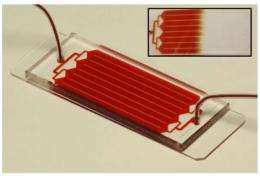Second-generation device more effective in capturing circulating tumor cells (w/ Video)

A redesigned version of the CTC-Chip – a microchip-based device for capturing rare circulating tumor cells (CTCs) – appears to be more effective and should be easier to manufacture than the original.
Called the HB-(herringbone) Chip, the new device also may provide more comprehensive and easily accessible data from captured tumor cells. Massachusetts General Hospital (MGH) researchers – including members of the team that developed the CTC-Chip – report the second-generation device in a Proceedings of the National Academy of Sciences paper that has been released online.
"The originally CTC-Chip worked wonderfully in a small-scale laboratory setting, but limitations arose when we attempted to increase production for larger clinical studies. The new device performs as well or better than the previous technology with several additional benefits," says Shannon Stott, PhD, of the MGH Center for Engineering in Medicine, co-lead author of the PNAS paper. "It also was able to capture something that had never been seen using either the CTC-chip or the most prevalent previous technology – small clusters of CTCs, the significance of which we need to study."
CTCs are living solid tumor cells found at extremely low levels in the bloodstream. Until the 2007 development of the CTC-chip by researchers from the MGH Cancer Center and the Center for Engineering in Medicine, it was not possible to get information from CTCs that would be useful for clinical decision making.
In the original device, patient blood samples are passed over a silicon chip covered with microscopic posts coated with an antibody that binds to most tumor cells. Not only did this design proved challenging to manufacture reliably and cost-effectively, but the smooth flow of blood around the microposts also limited the number of CTCs that came into contact with the antibody-covered surfaces. In their search to increase the capture of CTCs, the researchers found that passing samples through a chamber lined with a herringbone pattern of grooves – an approach developed elsewhere for quickly mixing independent streams of fluid – would generate a more chaotic flow that could significantly increase the number of captured cells.
The HB-Chip also can process larger-volume blood samples, increasing the ability to find rare CTCs. The microchip is mounted on a standard glass slide, which allows the use of standard pathology tests to identify cancer cells; and the device can be easily opened, giving access to CTCs for additional testing and growth in culture. Experiments comparing the HB-Chip to the CTC-chip found the new device captured more than 90 percent of cancer cells introduced into blood samples – a 25 percent improvement over the CTC-chip. Tests of samples from cancer patients found the redesigned device at least as effective as the original.
The HB-Chip also captured clusters of 4 to 12 CTCs from several patient samples but not from samples to which cancer cells had been added. No previous technology for capturing CTCs has ever found such clumps of tumor cells. "These clusters may have broken off from the original tumor, or they might represent proliferation of CTCs within the circulation," says Mehmet Toner, PhD, director of the BioMicroElectroMechanical Systems Resource Center in the MGH Center for Engineering in Medicine, the paper's senior author. "Further study of these clusters could provide valuable insight in the metastatic process."
Daniel Haber MD PhD, director of the MGH Cancer Center and a co-author of the study, says, "This new technology is a powerful platform that will enable increasingly sophisticated analyses of metastasis and support clinical research in targeted cancer therapies."
While the MGH has filed a patent for the HB-Chip, the research team will continue to develop the technology before potential licensing is explored. The study was supported by grants from Stand Up to Cancer, the Prostate Cancer Foundation, the National Institute for Biomedical Imaging and Bioengineering, the National Cancer Institute and the American Cancer Society, along with several additional funders.
Provided by Massachusetts General Hospital















